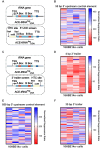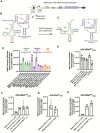Optimization of ACE-tRNAs function in translation for suppression of nonsense mutations
- PMID: 39673265
- PMCID: PMC11662937
- DOI: 10.1093/nar/gkae1112
Optimization of ACE-tRNAs function in translation for suppression of nonsense mutations
Abstract
Nonsense suppressor transfer RNAs (tRNAs) or AntiCodon-Edited tRNAs (ACE-tRNAs) have long been envisioned as a therapeutic approach to overcome genetic diseases resulting from the introduction of premature termination codons (PTCs). The ACE-tRNA approach for the rescue of PTCs has been hampered by ineffective delivery through available modalities for gene therapy. Here we have screened a series of ACE-tRNA expression cassette sequence libraries containing >1800 members in an effort to optimize ACE-tRNA function and provide a roadmap for optimization in the future. By optimizing PTC suppression efficiency of ACE-tRNAs, we have decreased the amount of ACE-tRNA required by ∼16-fold for the most common cystic fibrosis-causing PTCs.
© The Author(s) 2024. Published by Oxford University Press on behalf of Nucleic Acids Research.
Figures








Similar articles
-
ACE-tRNAs are a platform technology for suppressing nonsense mutations that cause cystic fibrosis.Nucleic Acids Res. 2025 Jul 8;53(13):gkaf675. doi: 10.1093/nar/gkaf675. Nucleic Acids Res. 2025. PMID: 40650978 Free PMC article.
-
An engineered glutamic acid tRNA for efficient suppression of pathogenic nonsense mutations.Nucleic Acids Res. 2025 Jun 20;53(12):gkaf532. doi: 10.1093/nar/gkaf532. Nucleic Acids Res. 2025. PMID: 40539513 Free PMC article.
-
Engineered transfer RNAs for suppression of premature termination codons.Nat Commun. 2019 Feb 18;10(1):822. doi: 10.1038/s41467-019-08329-4. Nat Commun. 2019. PMID: 30778053 Free PMC article.
-
Therapeutic promise of engineered nonsense suppressor tRNAs.Wiley Interdiscip Rev RNA. 2021 Jul;12(4):e1641. doi: 10.1002/wrna.1641. Epub 2021 Feb 10. Wiley Interdiscip Rev RNA. 2021. PMID: 33567469 Free PMC article. Review.
-
Suppressor tRNA in gene therapy.Sci China Life Sci. 2024 Oct;67(10):2120-2131. doi: 10.1007/s11427-024-2613-y. Epub 2024 Jun 24. Sci China Life Sci. 2024. PMID: 38926247 Review.
Cited by
-
ACE-tRNAs are a platform technology for suppressing nonsense mutations that cause cystic fibrosis.Nucleic Acids Res. 2025 Jul 8;53(13):gkaf675. doi: 10.1093/nar/gkaf675. Nucleic Acids Res. 2025. PMID: 40650978 Free PMC article.
-
Preventing vision loss in a mouse model of Leber Congenital Amaurosis by engineered tRNA.bioRxiv [Preprint]. 2025 Jul 11:2025.07.10.660754. doi: 10.1101/2025.07.10.660754. bioRxiv. 2025. PMID: 40672310 Free PMC article. Preprint.
-
High-fidelity and differential nonsense suppression in live cells and a frontotemporal dementia allele with human transfer RNAs.Nucleic Acids Res. 2025 Jul 19;53(14):gkaf730. doi: 10.1093/nar/gkaf730. Nucleic Acids Res. 2025. PMID: 40794874 Free PMC article.
-
Progress of personalized medicine of cystic fibrosis in the times of efficient CFTR modulators.Mol Cell Pediatr. 2025 May 5;12(1):6. doi: 10.1186/s40348-025-00194-0. Mol Cell Pediatr. 2025. PMID: 40320452 Free PMC article. Review.
-
An engineered glutamic acid tRNA for efficient suppression of pathogenic nonsense mutations.Nucleic Acids Res. 2025 Jun 20;53(12):gkaf532. doi: 10.1093/nar/gkaf532. Nucleic Acids Res. 2025. PMID: 40539513 Free PMC article.
References
-
- Mort M., Ivanov D., Cooper D.N., Chuzhanova N.A.. A meta-analysis of nonsense mutations causing human genetic disease. Hum. Mutat. 2008; 29:1037–1047. - PubMed
-
- Flanigan K.M., Dunn D.M., von Niederhausern A., Soltanzadeh P., Howard M.T., Sampson J.B., Swoboda K.J., Bromberg M.B., Mendell J.R., Taylor L.E.et al. .. Nonsense mutation-associated Becker muscular dystrophy: interplay between exon definition and splicing regulatory elements within the DMD gene. Hum. Mutat. 2011; 32:299–308. - PMC - PubMed
-
- Ballabio A., Gieselmann V.. Lysosomal disorders: from storage to cellular damage. Biochim. Biophys. Acta. 2009; 1793:684–696. - PubMed
MeSH terms
Substances
Grants and funding
LinkOut - more resources
Full Text Sources
Miscellaneous

